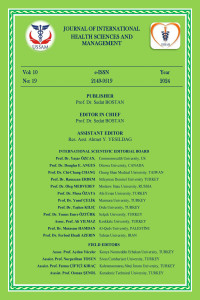Orginal Research
Sayı Hakemleri

 0000-0001-7362-5667
0000-0001-7362-5667





 0000-0001-8954-6314
0000-0001-8954-6314


 0000-0002-6970-0959
0000-0002-6970-0959

 0000-0002-9419-4816
0000-0002-9419-4816
 0000-0003-0729-1886
0000-0003-0729-1886

Amaç ve Kapsam
Journal of International Health Sciences and Management (JIHSAM), yönetim/idare ve sağlık bilimleri arasındaki ilişkiyi açıklamayı amaçlamaktadır. JIHSAM sağlık yönetimi/idaresi, halk sağlığı, klinik ve vaka yönetimi/idaresi, diş klinik yönetimi, ilaç ekonomisi ve yönetimi, hemşirelik yönetimi ve sağlık planlaması, politika ve yönetim ve diğer sağlık yönetimi konularını içerir.
Journal of International Health Sciences and Management (JIHSAM), Sağlık Bilimleri ve Yönetimi konularının araştırılması ve tartışılması için bir aracı olarak tasarlanmıştır. Özellikle sağlık hizmetlerinin küreselleşmesi, uluslararası hasta transferler (medikal turizm), hastane yönetimi, sağlık kuruluşlarının organizasyon davranışları, hasta hakları ve güvenliği ve memnuniyeti, sağlık politikası ve sağlık reformları, sağlık ekonomisi ve yaşam kalitesi alanlarında Sağlık Bilimleri ve Yönetimi araştırmacılarının iletişimini arttırmayı amaçlamaktadır.
Ayrıca dergi kapsamında aşağıdaki sağlık yönetimi konuları değerlendirilmektedir;
politik felsefe ve sağlık politikası, manevi sağlık, sağlık ve sağlık hizmetinin tarihi ve felsefesi, sağlık hizmetlerinde kalite için küresel işbirliği ve gelişim, sağlık akreditasyonu, sağlık kuruluşlarında risk yönetimi, sağlık hukuku, sağlıkta kalite değerlendirmesi, hastadır. sağlık çalışanlarında iş sağlığı ve güvenliği, sağlık hizmetlerinde finansal yönetim, sağlık kurumlarında taciz, sağlık kurumlarında şirket kültürü ve bağlılık enstitüleri, sağlık kurumlarında satın alma ve satın alma, sağlık kuruluşlarında malzeme ve cihaz yönetimi, sağlık kuruluşlarında performans yönetimi, sağlık bilgi sistemleri, sağlık hizmetlerinde yönetim ve organizasyon, sağlık kuruluşlarında muhasebe ve finans, sağlık hizmetlerinde stratejik yönetim, sağlık hizmetlerinde üretim yönetimi, sağlık ekonomisi, sağlık politikası ve planlaması, sağlık hizmetlerinde pazarlama, sağlık reformu, afet yönetimi, sağlık kurumlarında halkla ilişkiler, sağlık ve sosyal güvenlik sistemleri, sağlık sigortası, sağlık iletişimi, sağlık yönetimi ve etik, sağlık sistemlerinin ülke karşılaştırmaları, sağlık istatistikleri, hasta ve çalışan güvenliğinde risk yönetimi, uluslararası perspektifte hasta hakları, sağlık hizmetlerinde yenilik, sağlık hizmetlerinde insan kaynakları yönetimi, sağlık yönetiminde profesyonellik ve sağlık kuruluşlarında bilgi güvenliği.
Derginin hedeflerine ulaşmak için, yazarların diğer ülkelerdeki sağlık politikası uygulayıcıları ve diğer disiplinlerden uzmanlar tarafından anlaşılabilir olan teknik bir tarzda yazmaları tavsiye edilir.
Yazım Kuralları
Types of Articles
Journal of International Health Sciences and Management will be accepting submissions in three different formats:
(1)"Samples of the best practices in health management" of around 2,000 words (excluding abstract and references), concentrating on proposed, discussed, just passed and/or implemented management in one of the Health Systems and Institution. These do not have to present empirical data but analyze actor sand processes.
(2) "Full-length articles" of around 5,000 words (and not more than 6000 words), mainly empirical, analyzing the impact of health sciences and management. In addition, more theoretical, conceptual or methodological papers can be submitted.
(3) "Reviews/comparative analyses" of around 8,000 words (and not more than 10,000 words) can either be
(a) systematic reviews of Health Sciences and Management issues
(b) or examine certain aspects of health science and management in a systematic, comparative manner across a number of countries.
In all cases, Authors should provide sufficient background and context and discuss their findings in an international context to ensure that their manuscript can be appreciated by an international readership.
Besides these three main types of submissions, Health Science and Management is interested in publishing debate among the readers in the form of letters and repliques as well as commissioned editorials.
The material should not have been previously published in peer-review for all types of submissions. Publication as an abstract, academic thesis or discussion paper is permissible but needs to be stated in the cover letter to the editor upon submission.
Submission Preparation Checklist
As part of the submission process, authors are required to check off their submission's compliance with all of the following items, and submissions may be returned to authors that do not adhere to these guidelines.
ü The submission has not been previously published, nor is it before another journal for consideration (or an explanation has been provided in Comments to the Editor).
ü The submission file is in OpenOffice, Microsoft Word, RTF, or WordPerfect document file format.
ü Where available, URLs for the references have been provided.
ü The text is single-spaced; uses a 12-point font; employs italics rather than underlining (except with URL addresses); and all illustrations, figures, and tables are placed within the text at the appropriate points, rather than at the end.
ü The text adheres to the stylistic and bibliographic requirements outlined in the author Guidelines, which is found in About the Journal.
ü If submitting to a peer-reviewed section of the journal, the instructions in Ensuring a Blind Review have been followed.
In the event of alleged or suspected research misconduct, e.g., plagiarism, citation manipulation, and data falsification/fabrication, the Editorial Board will follow and act in accordance with COPE guidelines. Each individual listed as an author should fulfill the authorship criteria recommended by the International Committee of Medical Journal Editors (ICMJE - www.icmje.org). The ICMJE recommends that authorship be based on the following 4 criteria:
- Substantial contributions to the conception or design of the work; or the acquisition, analysis, or interpretation of data for the work;
- Drafting the work or revising it critically for important intellectual content;
- Final approval of the version to be published;
- Agreement to be accountable for all aspects of the work in ensuring that questions related to the accuracy or integrity of any part of the work are appropriately investigated and resolved.
Ethics committee approval must be obtained separately for the clinical and experimental human and animal studies required by the ethics committee decision. This approval should be stated and documented in the Method section of the article.
Size and Layout
Manuscripts should be written in English. They should be clear, concise and logical, and follow the suggested word length (see above) as well as the number of tables and figures (see below).
Manuscripts should be structured as follows (excluding samples of the best practices in health management):
- Cover letter
- Title Page (incl. Acknowledgements, e.g. to sponsors, and Conflict of Interest statement)
- Abstract-Keywords
- Introduction
- Materials and methods
- Results
- Discussion
- Conclusions
- Appendices (will be included as online supplementary material if the manuscript is accepted).
There should be no footnotes or endnotes in the manuscript.
Manuscripts that do not comply with the above mentioned manuscript guidelines will be considered as non-admissible. All submissions will be checked for plagiarism. The handling editor will be informed about any incorrectly cited text passages/ findings of plagiarism.
Figures, tables and equations
Figures and tables are encouraged but should not be too technical. Technical tables and especially equations or other formulae should be avoided. Except in exceptional circumstances, the admissible number of figures and tables together is 3 for samples of the best practices in health management articles, 5 for full-length articles and 6 for reviews and comparative articles. Additional figures and tables may be supplied as supplementary material. Figures and tables should still be legible when reduced in size for printing (for more details see below).
Abstract
An abstract of 220 words (and not more than 250) must be included in the submitted manuscript. As the abstract is often viewed separately from the article, it must be able to stand alone. It should state briefly and clearly the purpose and setting, the principal findings and major conclusions, and the paper's contribution to knowledge. If applicable, the country/countries/locations should be clearly stated, as should the methods and nature of the sample, the dates, and a summary of the findings/ conclusion. Please note that excessive statistical details should be avoided, abbreviations/acronyms used only if essential or firmly established, and the abstract should not contain references to other published work.
Keywords
Authors are asked to classify their submission using the provided classification system. They are also asked to include 3 to 6 keywords.
Illustration services
Figure captions
Ensure that each illustration has a caption. Supply captions separately, not attached to the figure. A caption should comprise a brief title (not on the figure itself) and a description of the illustration. Keep text in the illustrations themselves to a minimum but explain all symbols and abbreviations used.
Tables
Number tables consecutively in accordance with their appearance in the text. Place foot notes to tables below the table body and indicate them with superscript lowercase letters. Avoid vertical rules. Be sparing in the use of tables and ensure that the data presented in tables do not duplicate results described elsewhere in the article.
Throughout the manuscript text, Authors must indicate where approximately the figures and tables should be included.
References
Citation in text
Reference to a journal publication:
References (APA style): Cite references in the text as “last name, year”, e.g. (Turkmen, 2004). For multiple authors and page numbers in the text, e.g. (Turkmen et al., 2013:65).
References should be listed in alphabetical order, and include all the authors’ last names and initials, title, journal, year, volume, issue, and pages etc.
References
Reference Examples:
Gardner H, Bozkus T (2012). Multiple intelligences: the theory in practice. New York: Basic Books.
Li, G., Hart, A. ve Gregory, J., (1998). Flocculation and sedimentation of high turbidity waters, Proceedings , 9th Biennial Conference, International Association on Water Quality, 1137–1143, Vancouver: International presentation
Li, G., Hart, A. ve Gregory, J., (1998). Flocculation and sedimentation of high turbidity water, Water Resources, 25, 9, 1137-1143. :Article
Stanford P (2003). Multiple intelligence for every classroom. Journal of Education Psychology, 39(2): 81-89, http://www.iscs-a.org/content/39/2/80 (accessed May 14, 2013).
Turkmen M (2004). The effects of martial arts on children development. International Journal of Education Reviews, 8(3): 276-281.
Etik İlkeler ve Yayın Politikası
The secretary and editorial team review the submitted articles for content and relevance, regardless of the authors' names, qualifications, and affiliations.
It is ensured that the submitted texts that are determined to be suitable for the journal and the names of the file owners are anonymized.
However, even the section with the ethical statement in the text is cleared of the university's name and sent to at least 2 appropriate reviewers for evaluation. Responses and files from reviewers are also forwarded to authors, making sure they are anonymous. This process continues like this. All processes and versions are recorded online.
The only criteria for reviewer assignments. It is the mastery of the subject and the field.
All submissions must meet COPE's four criteria for scientific authorship. (see Submission Rules Page)
The editor welcomes and evaluates the objections and complaints submitted by all world citizens via e-mail regarding the published works.
All possible conflicts of interest between natural and legal persons must be declared in every study uploaded to the journal.
Studies published in the journal are open to direct revision in the first five days. In the next process, change requests will be published as correction articles in the next issue or reported as withdrawn.
Ücret Politikası
Journal of International Health Sciences and Management (JIHSAM) makale kabulü, işleme ve yayın sürecinde yazarlardan herhangi bir ücret talep etmemektedir. Dergi açıklı erişimli ve çift kör değerlendirmeli bir politika izlemektedir. Dergi yayın süreçlerinde kâr veya gelir beklentisi taşımamaktadır.

